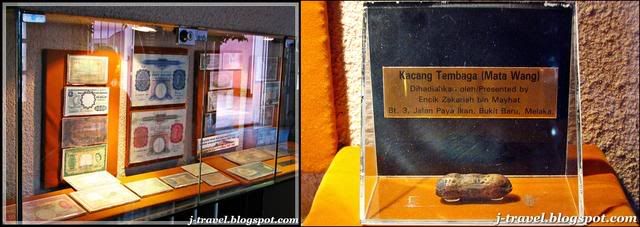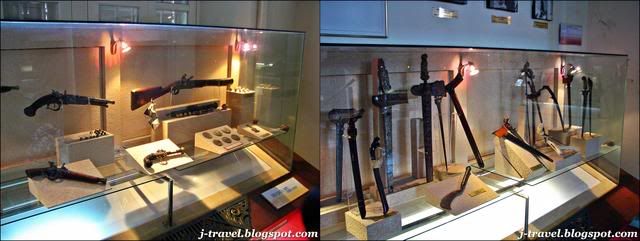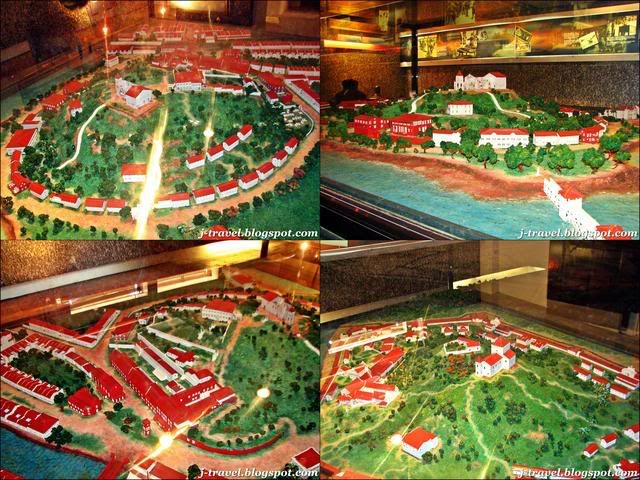The Museum Of History and Ethnography at Stadhuys, Malacca (Melaka)
After our breakfast at the hotel, we visited the Museum at Stadhuys. The "Museum Of History and Ethnography".
Entrance fees are MYR5.00 for adult & MYR2.00 for children below 12 years old. Kids below 5 year old are free.
After the entrance, this the first thing you explore.....
The drainage system that could be seen around the Stadhuys Complex now was either built during the British era earlier. This huge Stadhuys Complex seemed as though it did not have a drainage system at all during the Dutch era. Only when it was studied to plan the restoration work that it was found many drains criss-crossing in the Stadhuys Complex. This is one of those underground drains that were accidentally found while removing the cement floor.
Obviously the Dutch arranged and built the drainage system before the construction of the Stadhuys. This was typical Dutch architecture. This drain is not functioning now due to to the construction of an additional structure that somehow has blocked the flow.
Laterite blocks were lined up and cemented with lime plaster to form the drain. Then the drain was covered with granite slabs and tightly held together by clay. This part if the drain was purposely exposed to show the drainage system that existed in this building. - Sources from Stadhuys Museum
Obviously the Dutch arranged and built the drainage system before the construction of the Stadhuys. This was typical Dutch architecture. This drain is not functioning now due to to the construction of an additional structure that somehow has blocked the flow.
Laterite blocks were lined up and cemented with lime plaster to form the drain. Then the drain was covered with granite slabs and tightly held together by clay. This part if the drain was purposely exposed to show the drainage system that existed in this building. - Sources from Stadhuys Museum
The pictures of the museum for sharing......






 The pottery and ceramics industry has existed for a long time in Thailand. Because it depended on royal patronage, the production of Thai wares was localized in nature, dependent in the rise and fall of the state powers, and was therefore known by the location where they were made.
The pottery and ceramics industry has existed for a long time in Thailand. Because it depended on royal patronage, the production of Thai wares was localized in nature, dependent in the rise and fall of the state powers, and was therefore known by the location where they were made. In the middle of 13th century, a new kingdom was established in Sukhothai in Northern Tailand, and within 50 years, especially under King Rama Khamberg, the Empire of Sukhothai had become a cultural, trade and administrative center. This encouraged the growth of the ceramics industry to meet domestic needs as well as for export purpose. At first, the kilns in Sukhothai produced ceramics, which were low quality due to the rough clay found around the city. Sukhothai ceramics can be categorized into white wares and under glaze painted wares.
During the middle of the 14th century, a new ceramics center was open in Sawankhalok, not far away from the city of Sukhothai. The clay found in this area was finer quality that Sukhothai, enabling the production of better ceramics. The Sawankhalok ceramics industry grew, producing many varieties of ceramics, including artistic, decorative wares. The ceramics were not only white in colour but also brown and green, with an under glaze. - Sources from Stadhuys Museum






 After this, we proceed to another building on the right........
After this, we proceed to another building on the right........

After the stair case below, we finish our visit for the Museum.
 Related Melaka post :-
Related Melaka post :-* Panaroma Malacca (Melaka) Tour Bus
* An Evening at Malacca (Melaka)
* Stadhuys, Malacca (Melaka)
* St. Paul's Church, Malacca
* Aldy Hotel, Malacca (Melaka)
* Jonker Walk Night Market, Malacca (Melaka)
* Ole Sayang Nyonya Food Restaurant, Malacca (Melaka)
* Malacca (Melaka) River Cruise
* Dim Sum Restaurant at Malacca
* Special Homemade Herbal Tea at Malacca
* Portuguese Village, Malacca (Melaka)
* Famous Malacca's Popiah
* Hotel Equatorial, Malacca
* Taiwan Beef Noodle Malacca
* Nyonya Suan Restaurant, Malacca
* Mahkota Parade, Malacca
* Malacca (Melaka)
MY TRIPS - Home






























